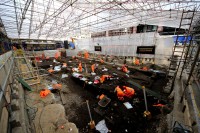 The construction of the high-speed Crossrail train line in London has generated the UK’s largest archaeological project. So far more than 10,000 artifacts spanning 55 million years of history have been unearthed at more than 40 worksites over 100 kilometers (62 miles) of the city. This week, archaeologists from the Museum of London Archeaology (MOLA) began to excavate the burial ground of Bethlehem Hospital, aka Bedlam, next to the Liverpool Street railway station. While the hospital building began life as a priory in 1247, it was seized by the crown in the 1370s and by the early 1400s was detached from its religious roots and administered by the City of London as a hospital for the mentally ill.
The construction of the high-speed Crossrail train line in London has generated the UK’s largest archaeological project. So far more than 10,000 artifacts spanning 55 million years of history have been unearthed at more than 40 worksites over 100 kilometers (62 miles) of the city. This week, archaeologists from the Museum of London Archeaology (MOLA) began to excavate the burial ground of Bethlehem Hospital, aka Bedlam, next to the Liverpool Street railway station. While the hospital building began life as a priory in 1247, it was seized by the crown in the 1370s and by the early 1400s was detached from its religious roots and administered by the City of London as a hospital for the mentally ill.
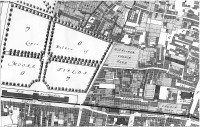 This burial ground, known as the New Churchyard, was built in 1569 and was in use until at least 1738, spanning some prime years for death in London: the English Civil War, the Great Plague of 1665 (and three other major outbreaks of Bubonic plague) and the Great Fire of 1666. Unaffiliated with any parish church, it was London’s first municipal burial ground. When the hospital itself moved to a new facility in Moorfields in 1676, the New Churchyard continued to be used as an overflow cemetery during mass death events, by people who could not afford or did not want (for religious or political reasons) a church burial.
This burial ground, known as the New Churchyard, was built in 1569 and was in use until at least 1738, spanning some prime years for death in London: the English Civil War, the Great Plague of 1665 (and three other major outbreaks of Bubonic plague) and the Great Fire of 1666. Unaffiliated with any parish church, it was London’s first municipal burial ground. When the hospital itself moved to a new facility in Moorfields in 1676, the New Churchyard continued to be used as an overflow cemetery during mass death events, by people who could not afford or did not want (for religious or political reasons) a church burial.
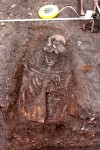 A single trial pit dug in 2011 found more than 100 skeletons, and preliminary surveys in 2013 and 2014 found more than 400. Archaeologists predict there are at least 3,000 individuals buried on this site and they plan to unearth them all over the next few weeks. The excavation is going on while the eastern entrance of the new Liverpool Street Crossrail station is being built, so surrounded with the noise and vibration of heavy construction, the MOLA team of 60 archaeologists will work in two shifts six days a week to dig through layer upon layer of skeletal remains. Right now they’ve dug down about a meter into the topmost layer and they’re finding individual burials were stacked on top of previous ones. When the wooden coffins decayed, the human remains pancaked downwards. Separating these bones pressed into each other over centuries is an arduous task, and they haven’t even gotten to the plague pits and mass graves in the lower layers.
A single trial pit dug in 2011 found more than 100 skeletons, and preliminary surveys in 2013 and 2014 found more than 400. Archaeologists predict there are at least 3,000 individuals buried on this site and they plan to unearth them all over the next few weeks. The excavation is going on while the eastern entrance of the new Liverpool Street Crossrail station is being built, so surrounded with the noise and vibration of heavy construction, the MOLA team of 60 archaeologists will work in two shifts six days a week to dig through layer upon layer of skeletal remains. Right now they’ve dug down about a meter into the topmost layer and they’re finding individual burials were stacked on top of previous ones. When the wooden coffins decayed, the human remains pancaked downwards. Separating these bones pressed into each other over centuries is an arduous task, and they haven’t even gotten to the plague pits and mass graves in the lower layers.
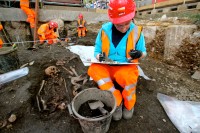 The skeletons will be excavated over the next four weeks. The remains will be moved the MOLA laboratory for osteological examination and tests that will hopefully determine diet, work, demographics, geographic origin, sex, medical history and more of the thousands of people interred at Bedlam. Archaeologists hope that tests on plague victims will provide a new understanding of how the plague pathogen moved through the early modern population.
The skeletons will be excavated over the next four weeks. The remains will be moved the MOLA laboratory for osteological examination and tests that will hopefully determine diet, work, demographics, geographic origin, sex, medical history and more of the thousands of people interred at Bedlam. Archaeologists hope that tests on plague victims will provide a new understanding of how the plague pathogen moved through the early modern population.
Jay Carver, Crossrail Lead Archaeologist said: “This excavation presents a unique opportunity to understand the lives and deaths of 16th and 17th century Londoners. The Bedlam burial ground spans a fascinating phase of London’s history, including the transition from the Tudor-period City into cosmopolitan early-modern London. This is probably the first time a sample of this size from this time period has been available for archaeologists to study in London. The Bedlam burial ground was used by a hugely diverse population from right across the social spectrum and from different areas of the City.”
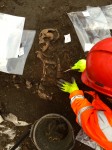 Identification of any of the remains is unlikely, to dramatically understate the case. Since the Bedlam burial ground didn’t keep its own records of who was buried there, 16 volunteers enlisted to scour the records of parish churches who made a note when parishioners were buried at “Bedlam” or “New Churchyard.” Archaeologists also appealed to the public for any family records, lore or anecdotes that might illuminate the history of the cemetery.
Identification of any of the remains is unlikely, to dramatically understate the case. Since the Bedlam burial ground didn’t keep its own records of who was buried there, 16 volunteers enlisted to scour the records of parish churches who made a note when parishioners were buried at “Bedlam” or “New Churchyard.” Archaeologists also appealed to the public for any family records, lore or anecdotes that might illuminate the history of the cemetery.
Here’s a video of researchers digging through the church registers at the London Metropolitan Archives. Keep your eye open for the “New Churchyard” annotations on the records.
[youtube=http://youtu.be/Q60UJMKkzlA&w=430]
When that video was shot, Jay Carver said they expected to find about 1,000 relevant burial records which would be used to help interpret the archaeological data from the dig and be compiled in a single database and made available to the public for genealogical or other research. Well, they left that already lofty goal in the dust. The final tally of names and histories of individuals buried at Bedlam cemetery was more than 5,000, an incredible accomplishment that testifies loudly to the dedication of the volunteers and the phenomenal record-keeping of 16th and 17th century churches and the London Metropolitan Archives.
According to the research Dr John Lamb (also known as Lam or Lambe), an astrologer and advisor to the First Duke of Buckingham, is among those buried at the site. Lamb was said to have been stoned to death by an angry mob outside a theatre in 1628 following allegations of rape and black magic. Others identified in the research include victims of riots by ‘Fanatiques,’ noted in the diaries of Samuel Pepys in January 1661.
Plague was the most common listed form of death, followed by infant mortality and consumption. The burial ground was established in 1569 to help parishes cope with overcrowding during outbreaks of plague and other epidemics. Crossrail workers recently discovered the gravestone of Mary Godfree who died in September 1665, as a result of the ‘Great Plague’ which peaked that year.
The Bedlam Burial Ground Register can be searched on the Crossrail website.
Once the skeletons are fully excavated, the MOLA team will continue to dig down through the medieval marsh and lost Walbrook River to the Roman layer. Tunnelers installing utility cables 20 feet below the surface in 2013 encountered Roman artifacts and human remains. The Liverpool Street excavation is scheduled to finish in September after which construction on the station will begin on the site. The human remains will be reburied after they are studied.
[youtube=http://youtu.be/cGRI-KerlOM&w=430]